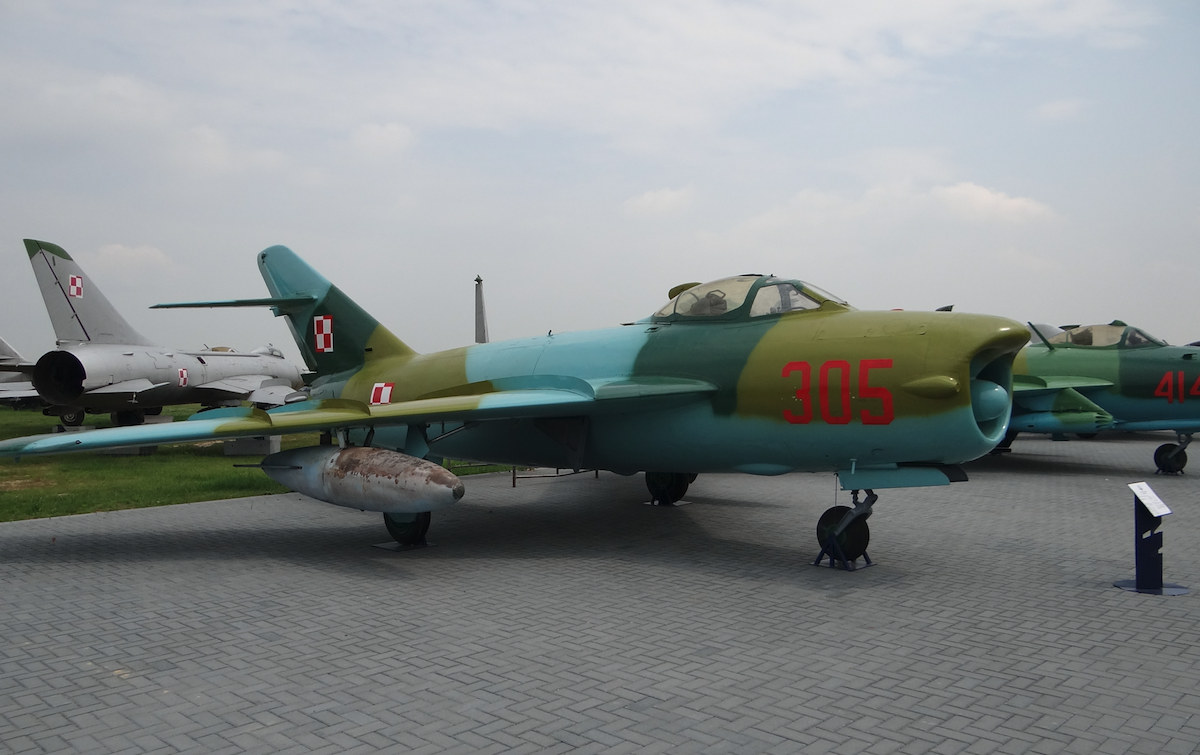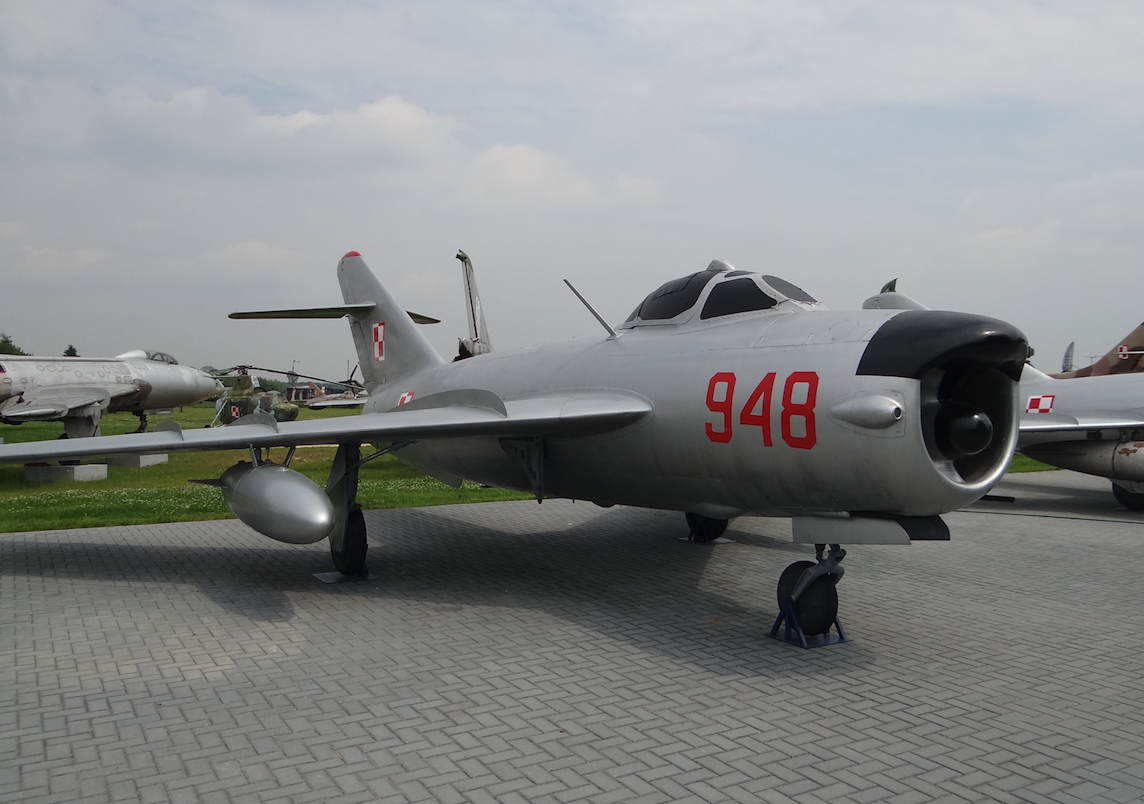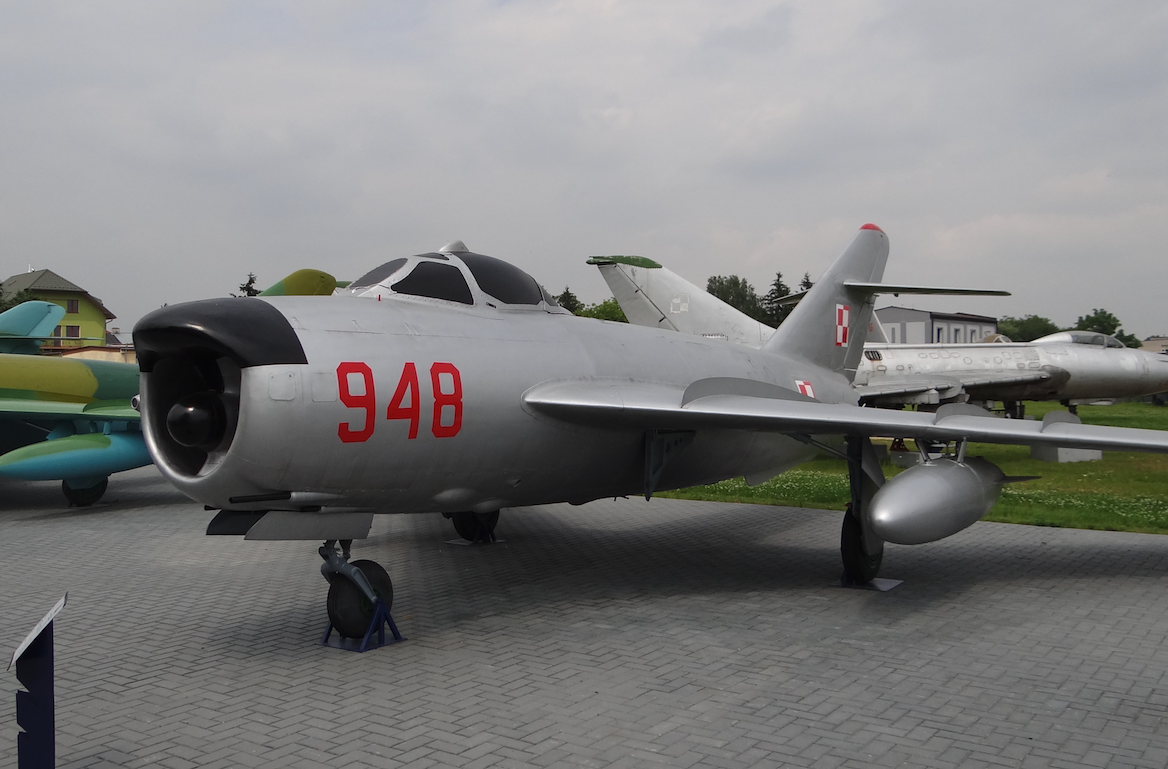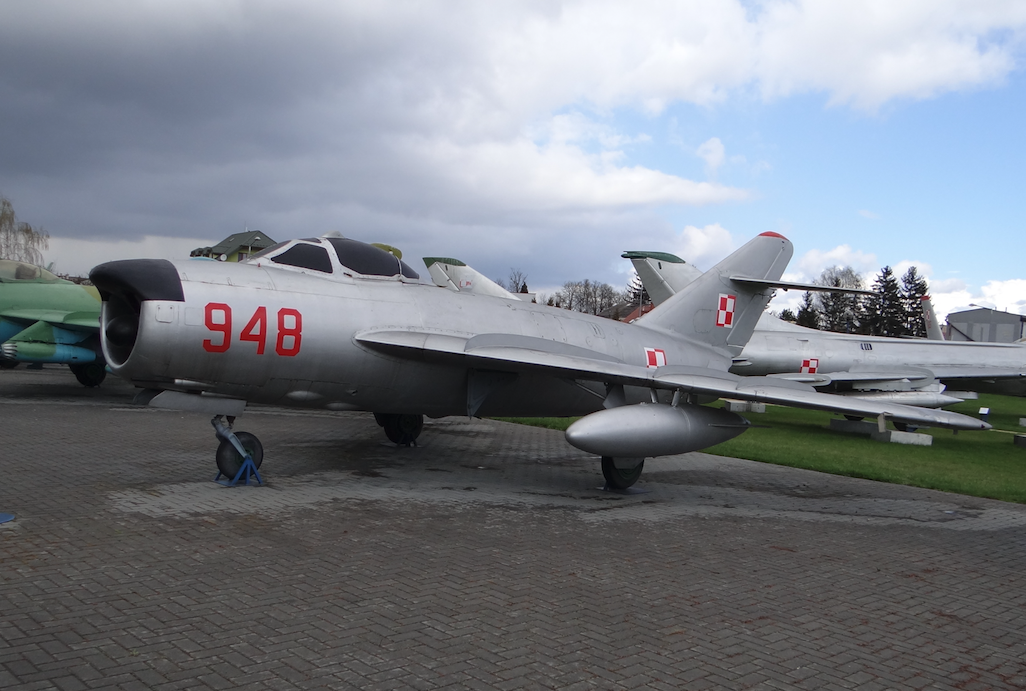Kraków 2018-11-24
MiG-17 PF / Lim-5 P
Radar Izumrud RP-5



The next flight meeting with Mr. Teofil Lenartowicz was very fruitful. We discussed many topics related to Mielec's aviation.
In this article, we will once again discuss the issue of Lim-5 P combat aircraft and Izumrud RP-5 radar stations. This topic is interesting because Mr. Teofil was one of the pre-flight testers of these devices, removal of malfunctions, transfer of Technical Control and military representation to the 21 WP. He traveled to most of the complaints reported on these devices by the Military Units operating them. It should be added that when Indonesia purchased 20 Lim-5 P aircraft in Poland, he was responsible for the trouble-free operation of these devices, technical training of the personnel and carried out repairs of damaged devices on the spot in the Indonesian army in Jakarta. This was done in 1961-1962.
12 MiG-17 PF aircraft bought for Poland belonged to the early production series. They were equipped with the Izumrud RP-1 radar station. However, the pattern from the later production series with the RP-5 radar station was chosen for serial production at WSK PZL Mielec. The RP-5 radar station had slightly better parameters and was slightly less emergency.
At the beginning of 1959, the plant in Mielec launched license production MiG-17 PF, under the designation Lim-5 P. The first copy with the serial number 1D-01-01 left the plant on January 18, 1959. After the flight, he was directed to Modlin, where a military Aviation Training Center was organized.
In 1959-1960, 129 aircraft were built in 6 production series. 40 of them were sold to the GDR. The last copy of 1D 06-41 was made on December 29, 1960. The main production lasted 24 months. In parallel, other aircraft were produced in Mielec: TS-8 Bies, TS-11 Iskra and production of An-2 began.
The plant producing Izumrud RP-5 radars has delegated its employees-advisers to WSK PZL Mielec to help the Polish side. Although probably not only.
Izumrud RP-5 radar was brought to Mielec in boxes. All the necessary components were included in one set: electronic blocks, radar screen, cable bundles, radar antennas with their movement mechanisms, dielectric shields of radar antennas. The assembly was carried out by Polish workers under the guidance of CCCP officers. The assembly was carried out on the basis of a license, i.e. attached technologies and drawings. If there were incompatibilities, and there were many, Polish designers explained this with advisers.
The assembly was very complicated because individual electronic blocks were located in different places of the airframe. Access to individual elements of the radar was from various places: from the cockpit, through the upper hatch to the electronic compartment, from below after leaving the tow truck with cannons.
Due to the large number of Lim-5 P aircraft (129 units), it quickly became apparent that a dozen or so employees of the Mielec plant had to be trained so that they could make adjustments and replace damaged components of these devices. Controllers in the fixture laboratory, constructors, technologists and other services were trained.
Each device mounted on the plane had its production certificate with all data. There must always be an entry for the accessories laboratory controller who, prior to mounting the unit on an airplane, checked its operation at the appropriate test stand. If there was no such entry, it could not be mounted on the plane.
The entire electronic system of the radar was based on electron tubes, which due to their properties were not very resistant to defects. For example in glowing circuits, with large and sudden changes in temperature, and finally high humidity. In addition, the electronics needed adjustment. The change in the emission of electron tubes caused a variety of malfunctions, and the most common effect of the malfunction was that the target shown in the viewfinder was in circles.
For radar regulation, a remote station for calibrating radars installed in Lim-5 P aircraft was built at a remote location in Mielec. This secluded place resulted from the need to limit the impact of electromagnetic waves on the radar. This position was popularly called "Taiwan". Electrical power was brought there. There were two seats inside, for two planes. Planes were rolled in front of the building. The plane did not fit the whole, only the front part, so that the cabin was inside and the fairing could be fully opened without exposing it to rain. Before the plane there was a window made of transparent plexiglass, i.e. material that did not dampen radar waves. At a distance of 800 m from the building, a metal triangle was placed about 80 cm in size. He was shaped to focus the reflected beam returning to RP-5. This triangular shape resulted from the wave characteristics, and the distance of 800 m resulted from effective fire from on-board cannons.
The said triangle on the radar screen was in the form of a spot which was the target. This spot should be in the center. She was often not in the middle and spinning around the screen. It had to be adjusted. A large stain on the screen represented a menacing storm cloud, while the plane was a small spot. As it approached, the dot changed into a cross, and when captured, it was in the reticle where it was the target. From that moment she looked completely different. This goal was called with the Russian "bird". It had wings with transverse lines. As the target approached, the wings lengthened and the number of lines determined the distance to the target. Three transverse lines on the wings marked a 400-meter distance. The pilot, having a "bird" in the center of the viewfinder, pressed on the joystick the trigger of the cannon, simultaneously activating the camera with the projectile, i.e. the camera. It should be added that the "bird" was exactly in the place of the invisible target, if it was at night or in the clouds. The radar included ballistics of the target.
After adjustment, the electronic blocks were sealed. All aggregates and even smaller components are sealed by manufacturers. Because the radar manufacturer's representative did not want to sit idle while the mechanics calibrated the radar, he gave seals to the mechanics. In this particular case, the WSK plant went to the hands of the Soviet adviser, and he WSK. There was no downtime at work because of this, and an advisor was not always needed. Because there would be cases of calling him to work at night.
The RP-5 radar could be started before take-off or during flight. He reached work readiness after about 120 seconds. The pilots liked to use the RP-5 very much during the entire flight, because by observing they avoided threatening storm clouds, and after leaving the horizontal flight they had visible ground on the screen.
RP-5 has two antennas. The upper one is the space observation antenna, searching. The bottom is the target tracking antenna. The upper antenna shows the image on the radar screen, which is located on the right side of the dashboard. A rubber tube is attached to the screen, to which the pilot looks. The tube improves visibility on the screen. When the radar captures the target, it automatically switches to tracking. In addition, the indicator light (light signal) lights up. Then the pilot was looking at the sight and directing the entire aircraft tried to approach the target at a distance of 800 m or less to open fire.
An additional device that supported the pilot was the "own-alien" system. When the aircraft was in the radar beam of another aircraft, the pilot in the headphones heard a sound signal, such a "squeak". It meant for him that in a moment he could get a series from the cannon and should immediately get out of the opponent.
RP-5 was a relatively emergency radar. After a radar failure occurred on a plane in combat regiment, a telegram was sent to WSK PZL Mielec. The telegrams did not have much relevant information, and for this reason there were additional problems, and the repair time increased.
The service from the factory did not have its own transport. You had to get on the train and, like every citizen, get to the place where the regiment was stationed. When you had to take an electronic block with you, by law, you were assigned a guard serviceman from the Mielec plant. The guards then wore black uniforms and round hats, and in winter black coats. They had only a long weapon at their disposal. Therefore, on the train, in the compartment, passengers often thought that the guard was escorting the prisoner.
In the initial period of Lim-5 P aircraft production, until around 1965, users' complaints were handled by a small Technical Control Department of KT, which did not have specialists familiar with the Lim-5 P radar equipment. After the production of this aircraft, a large group was dissolved, leaving the "Start" "Only the three RP-5 trial participants. Of these three, Mr. Teofil was the only one to complain about RP-5. The KT facility, when it received a complaint from the Military Unit, notified the Start Department, which was sending Mr. Teofil to settle the complaint. It resulted in adventures as described below.
Mr. Teofil mentioned the story at the Wrocław Główny station. Coming from Pomerania, they had a change in Wrocław. They were afraid that they would miss the train to Przemyśl. When the train entered the station, the train to Przemyśl was already on the second platform. Mr. Teofil, along with a guard with a rifle, ran hard at his feet. They sat in the compartment - Where's the package? Run back to the previous train. Luckily he didn't leave. The package was in the upper shelf compartment, unmoved. The story ended happily, because they still managed to take this train to Przemyśl. Fear to think what would happen after losing the package with the electronic block. Presumably prison. And the finder wouldn't even know what it is.
It should be mentioned that the regiments faced operational difficulties of the RP-5 device. It is true that the Air Force command sent the officers to the CCCP for training in advance. They were to supervise the operation of RP-5 and to train mechanics in this field. Unfortunately, it happened differently. The CCCP trainees were promoted to senior positions immediately after returning to the country and they didn't like to chase at the airport with RP-5. Mr. Teofil did not meet a single senior regiment engineer who was in training at CCCP and knew the RP-5 device to the extent to ensure proper operation. This situation has significantly contributed to the increase in the failure rate of these devices, and as a result of abandoning the use of native interceptors in our army.
Lim-5 P aircraft quickly became obsolete. All the others in service were handed over to Bydgoszcz, where the Izumrud RP-5 radars were dismantled and the aircraft became the Lim-6 M. Assault Radars. Izumrud RP-5 radars were scrapped. No copy has survived. Written by Karol Placha Hetman
Kraków 2018-11-24
161b MiG-17 PF / Lim-5 P
Radar Izumrud RP-5
Poland
Construction
Fighter with radar sight.

Construction Lim-5
The aircraft is a consistent development of the MiG-15 bis (Lim-2) design, which is intended primarily for a new power unit equipped with an afterburner, the used predecessors did not have. The whole system is left, but thanks to the longer power unit, the extension of the submission of the fuselage, which made the aircraft slimmer. A clearly more powerful propulsion tractor was not created, however, that the aircraft became a supersonic structure. It is true that the machine is capable of reaching speeds equal to or slightly higher than Ma-1, and in horizontal flight, but it only lasts a short time and is paid for by considerable fuel consumption. At least the most important thing on serial aircraft is the automatic mount, which at M-0.97 puts out the brakes and retracts them automatically when the speed drops to Ma-0.92. So it's a typical fighter jet not to use sound speed.
Single-engine, single-seat front fighter, built in a classic layout. Medium wing, with slanting wing. Half-shell construction, riveted.
An oblique wing, called a sickle wing, with a skew angle of 45 degrees at the fuselage and 42 degrees further. Laminar profile S-12s at the base and SR-11 at the end were used. The area of the wings is 22.6 m2, wedge angle 1 degree, rise -3 degrees, relative thickness 8%, elongation 4.08, convergence 1.23. Single girder design with rear auxiliary girder. 5.1 kg weight at the end of each wing. Flaps with a total area of 2.86 m2 swing out 20 degrees to take off and 60 degrees to land. Shuttlecocks with a total area of 1.6 m2 are tilted up and down by 18 degrees. The left aileron is fitted with a trimmer moved by an electric motor. On the upper surface of the panels three pairs of aerodynamic steering wheels. The sash is mounted to the hull with four fittings. The fuselage has a circular section technologically divided into two parts. The front part consists of 13 frames, the rear part of 18. The frame and the rear wing girder are mounted to frame 13. The maximum hull diameter is 1.45 m, the elongation is 6.17 m. The thickness of the coating varies from 1.5 to 1 mm. The air duct walls are 0.8 mm thick. Aerodynamic brakes with a total area of 0.98 m2, are pivoted by an angle of 55 degrees. The brakes are operated by a remote control, and additionally an automatic device that does not allow to exceed critical speeds. At Ma-0.97, the brakes open and close at Ma-0.92. Pilot's cabin partly armored from below. The glazing is a fixed front windbreak with a central armored window and a fairing moved backwards by hand. A periscope at the top of the glazing to observe the rear zone. In the cabin, an overload protection system with PPK-1 garment and a chair thrown out with a face cover. Catapulting is allowed on flights over 250 m and up to a speed of 850 km / h.
Vertical fixture with an angle of 56 degrees, area of 4.26 m2, including 0.947 m2 of rudder. Swivel angle of 25 degrees. Horizontal fixture with an angle of 45 degrees, an area of 3.10 m2, including 0.884 m2 of rudders. Trimmer on the left helm. Headsets tilted 32 degrees up and 16 degrees down.
Front chassis with 480 x 200 wheel dimensions, main with 660 x 160 wheels. Chassis base 3.368 m, wheelbase 3.849 m.
Engine Lim-5.
The license Lim-5, Lim-5 P built in Poland are powered by engines also produced under license by the Polish industry in WSK Rzeszów. It is a Lis-5 engine (license engine) with 1 x 26.46 kN (1 x 2 700 kG) thrust, and with post-combustion 1 x 33.12 kN (1 x 3 380 kG).
The afterburner is connected to the engine and constitutes an extended and properly formed exhaust pipe. A set of injectors was placed there, through which additional fuel is supplied, and its combustion causes an increase in thrust. The afterburner is ended with an adjustable nozzle. The nozzle is completely open during the afterburner operation. When the afterburner is off, the moving segments close together reducing the cross-section of the outlet opening. The engine fuel is supplied by the PCR-1-5 pump.
The fuel was placed only in the fuselage of the aircraft, in the same way as in the Lim-1 / -2 fighter. the main soft fuel tank is located between the cab and the engine and has a capacity of 1,200 (1,250) liters. The second metal-type tank consists of two halves covering the engine at the rear of the hull. It has a capacity of 2 x 165 liters.
The internal fuel supply can be increased by using tanks suspended under the wings with a capacity of 2 x 400 liters. These tanks are made of duralumin sheet or plastic. There is a possibility of their drop during flight.
Written by Karol Placha Hetman
Kraków 2007-05-01
Section 1956-05-25
WSK Mielec (LZR) MiG-17, Lim-5, Lim-6
Poland
Tally
The list is in another section.
Written by Karol Placha Hetman
